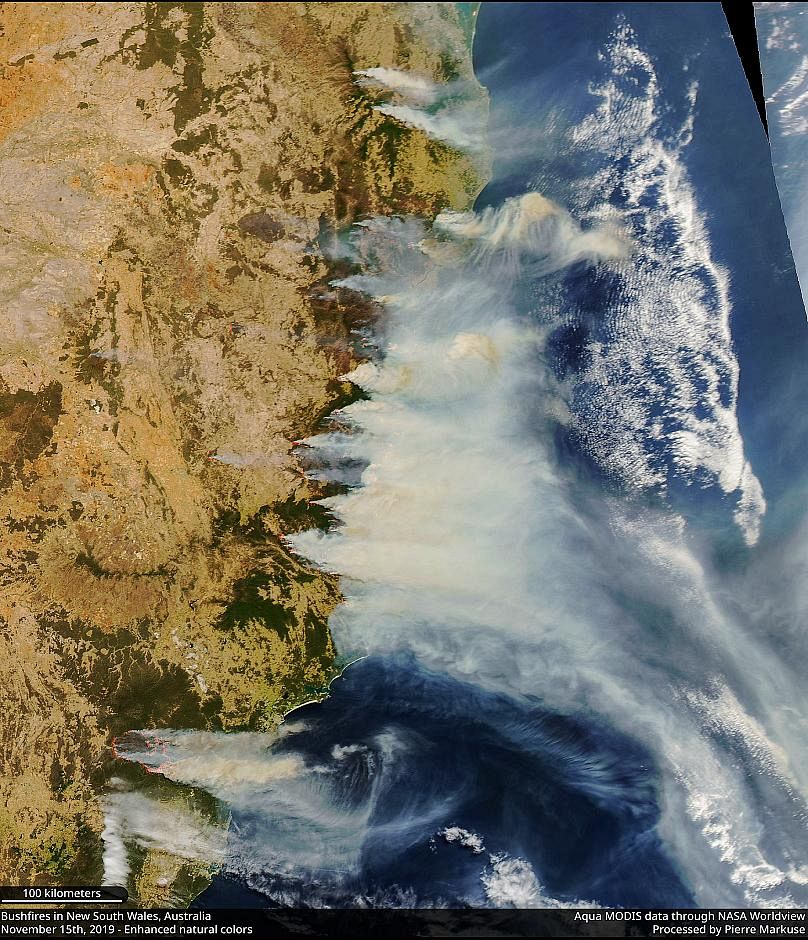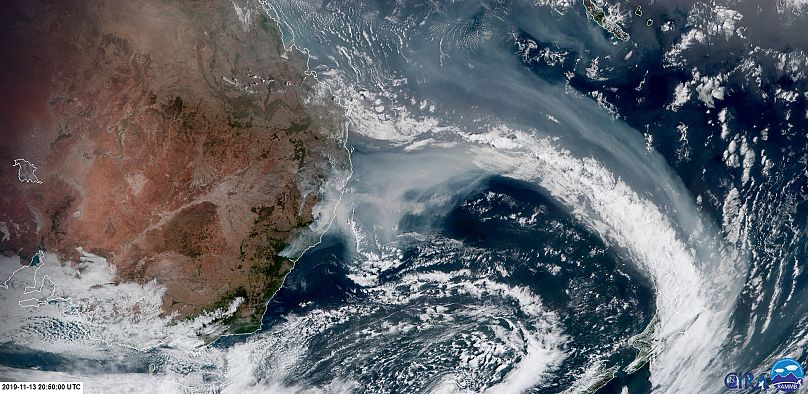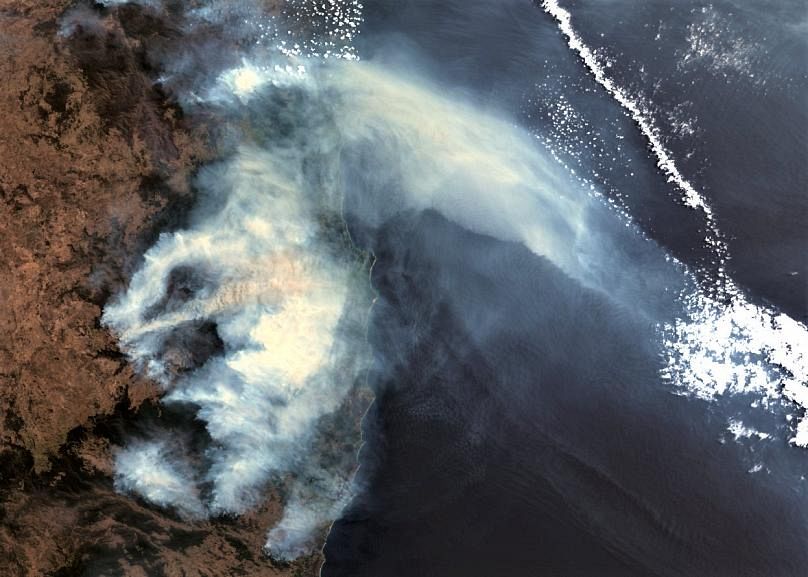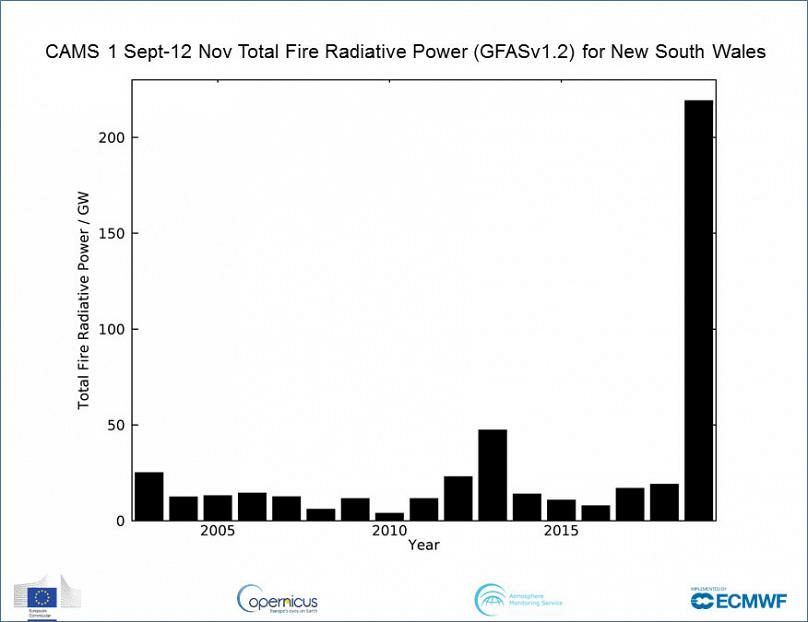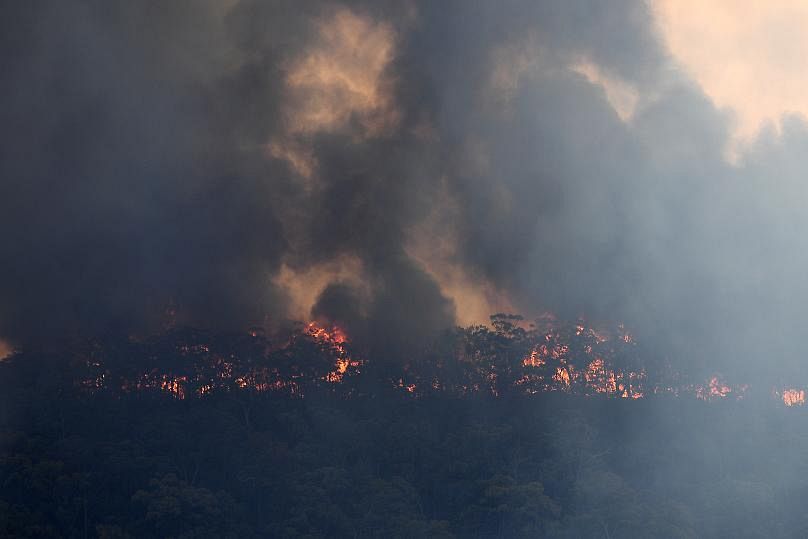The fires have rekindled the debate about the climate crisis in the country, which is one of the world's largest exporters of coal.
This is what the unprecedented wildfires on Australia's east coast look like from space.
Around 12,000 square kilometres have burned in New South Wales and Queensland since July, an area larger than Jamaica. The fires have caused four deaths, injured more than a hundred and destroyed more than 300 homes.
And this is just the beginning of the Australia region's usual fire season.
This chilling image of the east coast was obtained by blogger Pierre Markuse using NASA's Aqua MODIS satellite.
Meanwhile, Polish forestry engineer Kamil Onoszko obtained this animation with the Japanese satellite Himawari 8.
Smoke from the fires is crossing the Pacific and arriving regularly in South America. Onoszko's pictures showed the extent of the column of smoke travelling across the ocean.
The scientist Colin Seftor showed how the smoke reached South America using the aerosol index.
The Atmospheric Surveillance Service of the European Earth Observation Network Copernicus (CAMS) has published a report on these unprecedented events which notes that "New South Wales has experienced unprecedented fires", including "in parts of the state that have not experienced fires like this before".
"We've been closely monitoring the intensity of the fires and the smoke they emit," the report quotes Mark Parrington, principal scientist at CAMS, saying. "When comparing the results with the average of the last 16 years ... they are very unusual in number and intensity, especially in northeastern New South Wales."
This graph prepared by Parrington, studying the radiation of the fires in New South Wales, depicts the exceptional nature of the event:
These fires have revived the debate about the climate crisis in the country, which is one of the world's largest exporters of coal.
A dozen Australian mayors have signed a manifesto on Friday asking the government to recognise the link between the climate crisis and the fires amid this year's extreme temperatures and drought.
"The catastrophic conditions of these fires were, at least in part, caused by climate change," says the manifesto, signed by mayors of several towns affected by fires, such as Bellingen in the state of New South Wales and Noosa Shire in Queensland.
The Liberal-National Executive, a strong advocate for the exploitation of coal, the fossil fuel that contributes most to the climate crisis, has tried to avoid the global warming debate.
Australia's hottest summer was recorded last year, with temperatures of almost 50℃ in some parts of the territory.
The force of these fires has motivated a part of the public, politicians such as those from the Green Party and experts to ask Prime Minister Scott Morrison's government to put aside the country's ideological debates and listen to the warnings of scientists.
Morrison has refused to acknowledge the link between the climate crisis and forest fires, arguing that attention should be on victims and control of the flames.
"There is a time and place to discuss controversial and important issues; it is now important to focus on the needs of Australians who need help," he told reporters last Tuesday.
"Climate change is real, you don't see it," a protester shouted at Morrison during his tour of the affected areas in New South Wales, which is also the one that has suffered most from one of the worst droughts in decades.
A group of more than twenty ex-chiefs of Australian firefighters has tried to meet with Morrison since April because they knew a fire crisis was coming and thought that the climate crisis is making the summer seasons be longer and more deadly.
"Climate change has 'superchanged' the problem," former South Wales Fire and Rescue Service Chief Greg Mullins told reporters in Sydney, stressing that "an increase in a temperature degree implies that extremes be more extreme and put lives at risk".
Morrison, who gave a speech in Parliament last February with a piece of coal in his hand to defend his exploitation and seeks to sanction environmentalists who boycott resource extraction businesses, says Australia does not pollute as much as others countries
Australian Vice Premier and National Party leader Michael McCormack has called the Green Party "rabid lunatics of the city" because the party acknowledges the link between the fires and climate change.
The government of Australia, whose economy depends on exports of minerals that totalled €171,149 million in the last fiscal year, says it will reduce its emissions by 26-28% by 2030, in compliance with the Paris Agreement.
Australia contributes to 5% of the world's total climate pollution, according to research by Berlin-based science and policy institute Climate Analytics.
A study by the Climate Analytics Institute indicates that if Australia continues to approve mining projects such as Adani, the world's largest coal mine in Queensland, it will be responsible for 17% of polluting emissions by 2030.












